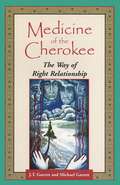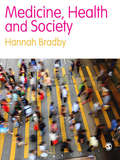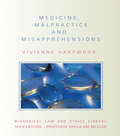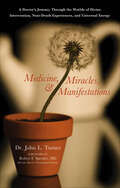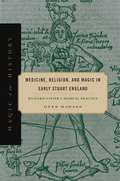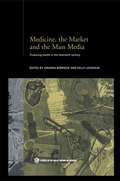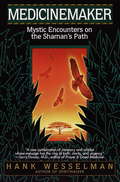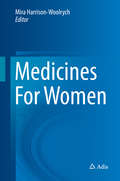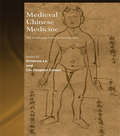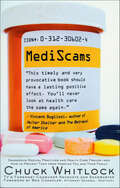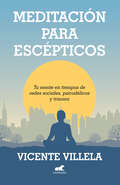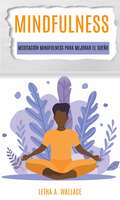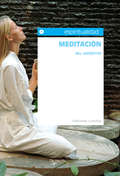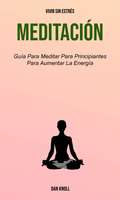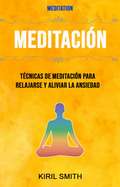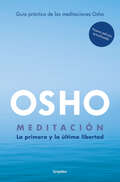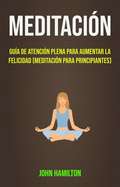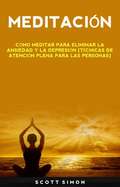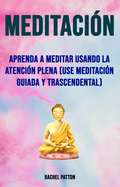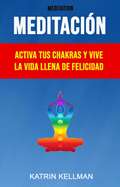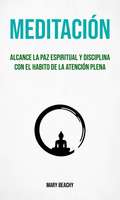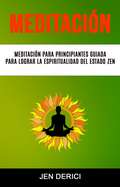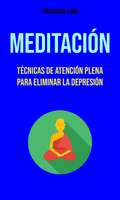- Table View
- List View
Medicine in the American West (Cornerstones of Freedom)
by Lucile DavisPracticing medicine in the American West was difficult and dangerous. People who practiced medicine often could not make a living. But those who did accomplished two things that were very important to the future of the United States. They helped explore and develop the field of medicine as they explored and settled the American West.
Medicine of the Cherokee: The Way of Right Relationship
by Michael Tlanusta Garrett J. T. GarrettDiscover the holistic experience of human life from the elder teachers of Cherokee Medicine. With stories of the Four Directions and the Universal Circle, these once-secret teachings offer us wisdom on circle gatherings, natural herbs and healing, and ways to reduce stress in our daily lives.
Medicine, Health and Society (Bsa New Horizons In Sociology Ser.)
by Hannah BradbySharp, bold and engaging, this book provides a contemporary account of why medical sociology matters in our modern society. Combining theoretical and empirical perspectives, and applying the pragmatic demands of policy, this timely book explores society's response to key issues such as race, gender and identity to explain the relationship between sociology, medicine and medical sociology. Each chapter includes an authoritative introduction to pertinent areas of debate, a clear summary of key issues and themes and dedicated bibliography. Chapters include: * social theory and medical sociology * health inequalities * bodies, pain and suffering * personal, local and global. Brimming with fresh interpretations and critical insights this book will contribute to illuminating the practical realities of medical sociology. This exciting text will be of interest to students of sociology of health and illness, medical sociology, and sociology of the body. Hannah Bradby has a visiting fellowship at the Department of Primary Care and Health Sciences, King's College London. She is monograph series editor for the journal Sociology of Health and Illness and co-edits the multi-disciplinary journal Ethnicity and Health.
Medicine, Malpractice and Misapprehensions (Biomedical Law and Ethics Library)
by V.H. HarpwoodAnalyzing the level of claims for clinical negligence in the light of the most recent trends and discovering whether there is indeed a litigation crisis in healthcare, this book is a topical and compelling exploration of healthcare and doctor-patient relationships. The author: identifies and analyzes the growing pressures on doctors in modern society, placing their role in context explores some of the myths surrounding media claims about malpractice considers the practice of ‘defensive medicine’ and the difference between defensive practices and sensible risk management examines external pressures, such as political interference with clinical practice in the form of target-setting and what might be described as a culture of creeping privatization of healthcare. Covering the topics of medicine and the media and the causes of occupational stress among doctors, this volume is a must read for all students of medical law and medical ethics.
Medicine, Miracles, & Manifestations: A Doctor's Journey Through the Worlds of Divine Intervention, Near-Death Experiences, and Universal Energy
by John L. Turner“A fascinating real-life voyage through medicine and beyond. . . . Intensely human and readable. Full of hope and wonder. A truly heartwarming page turner.” —Robert Bruce, author of Astral Dynamics and Energy WorkMedicine, Miracles, and Manifestations is a nonfiction narrative about the surgical career and spiritual quest of neurosurgeon Dr. John L. Turner and his journey into the field of Integral Medicine. During his career as a board-certified surgeon, Dr. Turner’s curiosity drove him to explore nontraditional healing techniques that broadened the scope of recovery for his patients, including energy healing, chanting and meditation (approaches historically found in religious practices), soul travel, and astral projection. In this fascinating book, you will discover:• How metaphysical events such as remote viewing, telepathy, consciousness, and life after death are all verifiable manifestations of the way the human brain interfaces with the universal consciousness.• That consciousness persists after the death of the physical body• That our life is carefully planned before birth but there is an element of free will.• That we can interface with a spiritual world and a collective human unconscious.“I admire Dr. Turner for having the courage to share his life and truths with us. I truly recommend this book to every health professional and those willing to open their minds and accept the true nature of life. You will be touched by the stories he shares; his book can help you open your mind and become aware of new and exciting aspects of true healing and curing.” —Dr. Bernie Siegel, author of Love, Medicine & Miracles and Prescriptions For Living
Medicine, Religion, and Magic in Early Stuart England: Richard Napier's Medical Practice (Magic in History)
by Ofer HadassThe astrologer-physician Richard Napier (1559-1634) was not only a man of practical science and medicine but also a master of occult arts and a devout parish rector who purportedly held conversations with angels. This new interpretation of Napier reveals him to be a coherent and methodical man whose burning desire for certain, true knowledge contributed to the contemporary venture of putting existing knowledge to useful ends.Originally trained in theology and ordained as an Anglican priest, Napier later studied astrological medicine and combined astrology, religious thought, and image and ritual magic in his medical work. Ofer Hadass draws on a remarkable archive of Napier’s medical cases and religious writings—including the interviews he claimed to have held with angels—to show how Napier’s seemingly inconsistent approaches were rooted in an inclusive and coherent worldview, combining equal respect for ancient authority and for experientially derived knowledge. Napier’s endeavors exemplify the fruitful relationship between religion and science that offered a well-founded alternative to the rising mechanistic explanation of nature at the time.Carefully researched and compellingly told, Medicine, Religion, and Magic in Early Stuart England is an insightful exploration of one of the most fascinating figures at the intersection of medicine, magic, and theology in early modern England and of the healing methods employed by physicians of the era.
Medicine, Religion, and Magic in Early Stuart England: Richard Napier's Medical Practice (Magic in History)
by Ofer HadassThe astrologer-physician Richard Napier (1559-1634) was not only a man of practical science and medicine but also a master of occult arts and a devout parish rector who purportedly held conversations with angels. This new interpretation of Napier reveals him to be a coherent and methodical man whose burning desire for certain, true knowledge contributed to the contemporary venture of putting existing knowledge to useful ends.Originally trained in theology and ordained as an Anglican priest, Napier later studied astrological medicine and combined astrology, religious thought, and image and ritual magic in his medical work. Ofer Hadass draws on a remarkable archive of Napier’s medical cases and religious writings—including the interviews he claimed to have held with angels—to show how Napier’s seemingly inconsistent approaches were rooted in an inclusive and coherent worldview, combining equal respect for ancient authority and for experientially derived knowledge. Napier’s endeavors exemplify the fruitful relationship between religion and science that offered a well-founded alternative to the rising mechanistic explanation of nature at the time.Carefully researched and compellingly told, Medicine, Religion, and Magic in Early Stuart England is an insightful exploration of one of the most fascinating figures at the intersection of medicine, magic, and theology in early modern England and of the healing methods employed by physicians of the era.
Medicine, the Market and the Mass Media: Producing Health in the Twentieth Century (Routledge Studies in the Social History of Medicine #Vol. 19)
by Virginia Berridge Kelly LoughlinThis collection opens up the post war history of public health to sustained research-based historical scrutiny. Medicine, the Market and the Mass Media examines the development of a new view of 'the health of the public' and the influences which shaped it in the post war years. Taking a broad perspective the book examines developments in Western Europe, and the relationships between Europe and the US. The essays looks at the dual legacy of social medicine through health services and health promotion, and analyse the role of mass media along with the connections between public health and industry. This international collection will appeal to public health professionals, students of the history of medicince and of heath policy
Medicinemaker
by Hank WesselmanIn the brilliant visionary tradition of Carlos Castaneda, anthropologist Hank Wesselman first documented his spiritual journey in the acclaimed account Spiritwalker. Now he continues his travels through the spirit world in this astonishing book, leading us into the heart of one of the greatest mysteries of existence.Dr. Wesselman's inspiring quest began with a dramatic encounter on the island of Hawaii. Though he had feared his connection to Nainoa, a kahuna initiate and fellow mystic traveler, would be severed when he moved to San Diego, Wesselman would continue to merge minds with Nainoa. Over the next five years, the true purpose of their profound yet cryptic contact took shape. Wesselman had gained access to some inner doorway, putting him in the presence of a transcendent life force and intelligence. On the threshold of a dazzling new understanding of nature, he was a shaman in training, an initiate into the sacred, secret healing powers of the spirit world.This remarkable book gives us an unprecedented glimpse into the origin and the destiny of our species. Hank Wesselman has brought back from his extraordinary travels an extraordinary message: the keys to personal power and to the healing of all humankind.From the Trade Paperback edition.
Medicines For Women
by Mira Harrison-WoolrychIn this definitive new text, the major medicines, devices and vaccines used by women worldwide are brought together for the first time in a single volume. Written and edited by international experts with an evidence-based approach, the book offers a comprehensive summary of all the key areas of women's medicines. In the first part, issues relating to female drug exposure and considerations for prescribing for subgroups of women - for example during pregnancy and lactation - are presented in the context of contemporary clinical practice. In the second part, specific groups of pharmaceutical products are reviewed, including oral contraceptives, emergency contraception, treatment of chronic pelvic pain, hormone replacement therapy, bisphosphonates, herbal medicines for women, contraceptive devices and human papilloma virus (HPV) vaccines. Every chapter reviews and summarises the efficacy and safety of each group of products and concludes with a useful set of clinical take home messages. In the third part, broader perspectives are presented - from a primary care overview of prescribing for women, through to regulatory, political and religious aspects, including issues with women's medicines in developing countries. The final two chapters focus on risk communication and conclude that women themselves should be placed at the centre of all discussions about their medicines. The book is aimed at prescribers, other healthcare professionals and students in the field of women's health throughout the world. It is an extremely valuable resource for all in clinical practice, for students of medicine, nursing, pharmacy and related sciences, and also for those in medicines regulation, pharmacovigilance and the pharmaceutical industry.
Medieval Chinese Medicine: The Dunhuang Medical Manuscripts (Needham Research Institute Series)
by Christopher Cullen Vivienne LoIn recent decades various versions of Chinese medicine have begun to be widely practised in Western countries, and the academic study of the subject is now well established. However, there are still few scholarly monographs that describe the history of Chinese medicine and there are none at all on the medieval period. This collection represents the kind of international collaboration of research teams, centres and individuals that is required to begin to study the source materials adequately. The first book in English to discuss this fascinating material in the century since the Dunhuang library was discovered, the text provides a unique and fascinating interpretation of Chinese medical history.
Mediscams: Dangerous Medical Practices and Health Care Frauds—and How to Prevent Them from Harming You and Your Family
by Chuck WhitlockWhere their health is concerned, Americans want answers. Too often, what they get are false promises from medical "professionals" more intent on lightening their patients' wallets than helping to shave off those stubborn five pounds. These medical scam artists run from the petty to the downright dangerous, and their schemes can leave you poorer but wiser, hospitalized, or much worse... Now journalist Chuck Whitlock tackles the seedy world of medical scams, exposing everything from bogus pills that claim to relieve symptoms of drunkenness, to questionable weight-loss programs, to bizarre plastic surgery procedures.Called "the nation's leading scambuster" by Oprah Winfrey, Chuck Whitlock tackles treacherous HMOs, doctors, and charlatans. Then he shows the reader how to avoid falling victim to medical scams.
Meditaciones para escépticos
by Vicente VillelaCómo la introspección -meditar- puede transformar nuestra subjetividad e iluminar ciertas verdades sobre la conciencia humana. Un libro para todos los escépticos que miran con distancia el ejercicio de estar en silencio y meditar. El autor, ingeniero de profesión, llegó a la meditación desde el escepticismo total. En este libro plantea que la meditación como entrenamiento mental es central para cualquier persona en el mundo actual, y a través de ella revisita la experiencia psicodélica, las consecuencias del trauma, la influencia de las redes sociales y algunos principios budistas.
Meditaciòn Mindfulness para mejorar el sueño
by Letha A. WallaceAprenda a meditar en el momento presente para una vida de paz. Si cree que enseñar a los niños es difícil, se sorprenderá de lo fácil que es para ellos adoptar la atención plena. Lo que más me gusta es que para facilitarle la transición, especialmente cuando se trata de enseñar la atención plena a los niños, en el libro se incluyen algunos consejos antes de comenzar a enseñar. Estos consejos te ayudarán a garantizar el éxito y un entrenamiento efectivo de la atención plena. También incluye un guión genérico que puede desarrollar a medida que crece mejor y obtiene nuevas inspiraciones para sus ejercicios de atención plena. Stress is the biggest cause of most of our problems. It affects our physical and mental health to a great extent. Meditation is a state of mind where one disconnects himself completely from the outer world. One begins to concentrate on his breath and slowly tries to connect with the ultimate power. Controlling the breath and stopping one's self from outer distractions is the basic requirement of meditation.
Meditación
by Bill Anderton* El autor, Bill Anderton, le conducirá a través de las tradiciones y la práctica de la meditación, y le ayudará a llevar a cabo esta técnica de la forma adecuada. * Un libro que le mostrará en qué consiste la meditación y qué ocurre cuando medita, con el que aprenderá a utilizar técnicas de relajación y pensamientos positivos de manera efectiva. * Comprobará el poder de la meditación para potenciar su creatividad y su capacidad de autocuración. * La guía incluye numerosas meditaciones espirituales que se pueden practicar en cualquier momento. Bill Anderton comenzó a interesarse por la meditación en los años setenta, y desde entonces se ha dedicado a estudiar y a enseñar su práctica. Utiliza la meditación como un medio no sólo para el alivio de las tensiones, sino también para la maduración interior y la mejora de la calidad de vida. Ha escrito diversos libros y artículos sobre meditación. En la actualidad dirige el Pilgrims Centre de Gloucester, donde enseña técnicas de meditación y relajación.
Meditación (Vivir Sin Estrés): Para incrementar su energía (vivir sin estrés)
by Dan KnollEste libro de meditaciones para entrenadores en todos los deportes tiene un tema diferente para cada capítulo y meditaciones individuales sobre diferentes aspectos del juego mental del entrenamiento. Cada meditación tiene algunos pensamientos para su reflexión y tiene una afirmación única al final, que se utiliza para la meditación. Lee atentamente lo escrito y luego meditas en la afirmación. El libro incluye capítulos sobre cómo actuar en la zona de confianza, planificación del éxito, ser un líder fuerte, tener conversaciones poderosas, lidiar con las barreras para el éxito, tener una visión poderosa, entrenar bien, tener salud, ser un espíritu libre, estar centrado y ser creativo, y ser mentalmente fuerte. Se ha comprobado científicamente que la meditación tiene beneficios mentales y físicos para aquellos que se toman el tiempo de incluir en su día regularmente una práctica de meditación. Algunos de los beneficios científicamente probados de la meditación incluyen un aumento en el enfoque, lo que resulta en una disminución de la ansiedad y el estrés emocional, y es excelente para las personas que sufren ansiedad u otros trastornos relacionados con el estado de ánimo. Para aquellos que sufren ataques de pánico, una forma extrema de ansiedad que se acompaña de sentimientos de temor y respuestas físicas, como un aumento de los latidos cardíacos y una mayor cantidad adrenalina, practicar la meditación puede ayudar a minimizar estos síntomas en medio de un ataque y puede ayudar a prevenir futuros ataques.
Meditación ( Meditation): Empezando con la meditación
by Kiril SmithCada ejercicio presenta información resumida para ayudarlo a saber si es adecuado para usted antes de comenzar. Se da una breve descripción, junto con las emociones específicas que el ejercicio pretende evocar. Se proporcionan advertencias de activación, si las hay, para garantizar que aquellos que sufren ansiedad o trauma sepan cómo evitar un ejercicio en particular. Estas visualizaciones pueden ser de particular interés para curanderos, entrenadores, terapeutas y líderes espirituales. ¿Te sientes atrapado en tu práctica de meditación? ¿Has dejado de meditar por completo porque sientes que tu mente está demasiado inquieta? Retroceda y revise las soluciones a los obstáculos más comunes que se interponen en su camino. Esta breve guía (15 páginas) está repleta de consejos prácticos que le permitirán practicar con mayor conocimiento y entusiasmo renovado. El ritmo furioso y las demandas que enfrentamos una vez al día con frecuencia nos hacen sentir concentrados, agotados, agotados e incluso preocupados. La meditación es un enfoque simple, viable y útil para calmar su animada personalidad, relajar su cuerpo, progresar hacia la toma de tierra y encontrar la paz interna en medio de la confusión de la vida cotidiana.
Meditación (Edición ampliada con más de 80 meditaciones OSHO): Una guía práctica
by OshoUn gran clásico de OSHO, el manual para la práctica de la meditación. Las páginas de este libro nos transmiten un mensaje claro: la meditación no es una disciplina espiritual alejada de la vida diaria sino que, en su esencia, es el sencillo arte de ser consciente de lo que está sucediendo en nuestro interior y a nuestro alrededor. * Nuevas meditaciones* Nueva presentación de las Meditaciones Activas OSHO y de las Terapias Meditativas OSHO y nuevas meditaciones * Nuevas secciones como: los niños y la meditación * Meditaciones para aprender a morir, meditación y actividad deportiva * Meditaciones para gestionar nuestras emociones * Hacer del sueño una meditación y gestionar el insomnio * MindfulnessEn este libro, Osho nos presenta más de 80 prácticas meditativas fundamentales y responde, con claridad y sencillez, las cuestiones más relevantes sobre este tema, por ejemplo, qué es la auténtica meditación, cuáles son las claves y el objetivo específico de toda técnica meditativa o cómo vencer los obstáculos naturales que podrían surgir durante su práctica. El talento especial de Osho permite al lector profundizar en el espíritu y la consciencia de la meditación. Su clara visión es como un faro nítido y certero que posibilita la realización de la auténtica experiencia mística.
Meditación (Meditación Para Principiantes): Guía de atención plena para aumentar la felicidad (Meditación para principiantes)
by John HamiltonLa meditación debe ser simple y fácil de hacer, pero nosotros, como humanos, hacemos que este proceso natural de curación sea más difícil de lo que tiene que ser, y creamos estrés a diario que en realidad inhibe todo nuestro potencial. Puedes irte sin miedo y sin estrés y este es tu mejor punto de partida. Con esta guía para principiantes de técnicas de mediación simples para lograr su máximo potencial, le brindará las herramientas para avanzar de una manera precisa y fácil de describir. La clave es hacer un hábito diario de las cosas que estás a punto de aprender y continuarás creciendo. La meditación es básicamente una forma de entrenamiento de atención mental que apunta a despertarte más allá de tu mente consciente. Su proceso se conoce como presencia natural, que reconoce claramente lo que está sucediendo a tu alrededor. La meditación tiene numerosos beneficios tanto para su salud física como mental.
Meditación (Técnicas De Atención Plena Para Las Personas): Cómo Meditar para Eliminar la Ansiedad y la Depresión (Técnicas de Consciencia Plena para Todos)
by Scott SimonEste es un libro centrado en prácticas místicas. Aquí el lector encontrará prácticas y meditaciones místicas que le ayudarán a establecer una rutina mística adecuada, desde la configuración básica hasta la práctica más avanzada, mediante la cual un estudiante puede lograr esta última realización divina. La encarnación física de lo divino también es relevante, y esta se describe en el libro. El libro también lo ilustrará sobre los grandes beneficios que la meditación puede brindar a su salud, y cómo la meditación le ayudará a tener éxito en la vida en sus tareas diarias. Lea "Meditación para Todos: Cómo Hacer que sea Parte de su Vida Cotidiana". Conozca los principios y la información que se encuentran en el libro y póngalos en práctica. Esto es todo lo que necesitará para hacer que la meditación forme parte de su sistema. Así que manténgase en calma, viva una vida más productiva y más fructífera con la meditación diaria. Sea más consciente de sí mismo, de su entorno y de sus emociones meditando diariamente. Esto no quiere decir que tendrá que sentarse en una habitación oscura con las piernas cruzadas. De hecho, la meditación se puede personalizar para que se adapte a lo que usted quiera. Puede tener diferentes objetivos con la meditación y aun así alcanzar sus objetivos a través de los diversos tipos de meditación que están a su alcance. Conviértase en una persona más saludable a través de la meditación y descubra algo más de felicidad en su vida. ¡Compre hoy su libro!
Meditación (Use Meditación Guiada Y Trascendental): (Use la meditación guiada y trascendental)
by Rachel PattonLas técnicas de meditación antiguas muy básicas y más efectivas que ayudan a aliviar la vida de uno. La técnica del tratamiento y la sugerencia ayudan a superar las austeridades de la vida y, en última instancia, la antigua técnica de la respiración hace que la vida sea menos estresante y lo haga vivir en paz. Hay una forma más profunda de conocer y un conocimiento de sí más profundo que encontramos cuando desarrollamos una práctica de meditación. Encontramos nuestro centro donde estamos en contacto con nuestra profunda sabiduría y pasión. Cuando vivimos, entrenamos, competimos y entrenamos desde nuestro centro, encontramos más claridad sobre nuestras fortalezas y debilidades. Encontramos más claridad sobre las fortalezas y debilidades de nuestros atletas y equipos. Aprendemos que las barreras que parecen estar frenándonos a nosotros y a nuestros atletas son en realidad invitaciones para desarrollar, cambiar, mejorar y aprovechar la fuerza profunda que encontramos en el interior para seguir adelante con lo que nos ayudará a avanzar como entrenadores. Atletas, y equipos. Si está listo para actuar y cambiar su vida para mejor, ¡este libro definitivamente lo guiará en la dirección correcta!
Meditación : Activa Tus Chakras Y Vive La Vida Llena De Felicidad
by Katrin KellmanLa intención de este libro es difundir la alegría del Señor a quienes lo conocen; quienes se unen en hermandad con otros para que podamos alegrarnos en paz, gracia, descanso, amor y conocimiento de lo que Dios ha hecho por nosotros. Esperamos por el Cielo y ver a nuestros seres queridos de nuevo. Recordamos que este mundo no es nuestro hogar; solo estamos de paso. Nos unimos en la hermandad con otros que comparten el amor de Dios, con aquellos en necesidad y buscando lo perdido. Hay chances de que tengas y eso es normal. Fíjate, latentes en los recovecos de tu mente cada uno de estos pensamientos se convierten en cajas cerradas, cuanto más reflexiones en ellos. Por tanto, es un espantoso desastre. La meditación te ayuda a poner todos esos pensamientos en sus cajas y avanzar sin ideas prejuiciosas sobre la vida. La vida evoluciona y tú también y el único momento importante en tu vida es el ahora, aceptar quien eres y también aceptar que el cambio es inevitable y parte de la vida. Esa aceptación te ayuda a ir por la vida de una manera muy positiva. ¿Qué estás esperando? ¡No esperes más! Desplázate hacia arriba y dale clic al botón “compra ahora” para ¡comenzar el viaje hacia una vida de sueños!
Meditación : Alcance La Paz Espiritual Y Disciplina Con El Habito De La Atención Plena
by Jose Alfredo Hernandez DelgadoEl mejor libro de meditación ¿Y cómo podemos hacer nuestra preocupación en la primavera. Toda la información en este libro y su vida feliz en este libro.
Meditación : Meditación Para Principiantes Guiada Para Lograr La Espiritualidad Del Estado Zen
by Jen DericiSi nunca está en el presente es muy problable que no escuchará lo que su jefe le dice, las ideas que su esposo o esposa le dan, las preocupaciones que sus niños le transmiten y el feedback que su empleado le está dando. Todo se reduce a la falta de concentración y a la posibilidad de que sea poco productivo y tenga que lidear con conflictos de personas a su alrededoor porque a usted no parece importarle lo que ellos le tienen que decir. Esta situación lo puede conducir hacia un estado de insatisfacción e infelicidad sin importar qué tan favorable nuestra situación parezca. Cuando estamos en este estado constante de preocupación y de infelicidad, nuestros cuerpos producen la hormona del stress que causa destrozos en nuestro cuerpo ya que puede causar complicaciones relacionadas al stress como la hipertensión, stress crónico, depresión, fatiga suprarrenal, y muchas otras complicaciones relacionadas al stress. En la actualidad, muchos creen que la meditación es antigua o que es una práctica que las personas al margen de la sociedad practican. No podrían estar mas equivocados. Cada vez mas personas se están dando cuenta de los beneficios que obtienen de este proceso y los doctores ya lo están aconsejando para que las personas comiencen la práctica de meditación y conciencia con el propósito de aliviarlos de las enfermedades relacionadas al stress. Por lo tanto, si desconecta los distintos tipos de stress de su vida y aprende a meditar, usted podrá vivir y gestionar de mejor manera su vida y podrá disfrutarla mucho mejor. No espere más y descubra LA LLAVE a una nueva vida que sea mejor.
Meditación : Técnicas De Atención Plena Para Eliminar La Depresión
by Prasanna LoweMeditation is a simple practice to know your true authentic self. In the book, you will find different ways of meditation that can help you to move deeper within the self, and experience the truth of the self. La meditación es una práctica simple para conocer tu autentico y verdadero ser. En este libro encontrarás diferentes maneras de meditar que pueden ayudarte a moverte profundamente en tu ser y experimentar la verdad del ser. La práctica de la meditación está involucrada totalmente en la rueda del karma, y, así, quien inicia en la práctica de la meditación comienza un viaje de vida hacia una nueva percepción. No adquieres nada nuevo, al contrario, tiras las cosas que se han acumulado en tu mente. Ser capaz de sintonizar con el mundo exterior y entrar en el profundo reino de la auto reflexión es una habilidad vital para tener si quieres encontrar paz interior. Ser capaz de limpiar tu mente y enfocarte en el positivismo es algo increíble de aprender. Recuerdo mi vida anterior, empecé a meditar y lo principal que me faltaba era un sentido de dirección y claridad; ahora medito dos veces al día y ha revolucionado por complete mi vida. Al principio, crear el hábito de la meditación podrá parecer problemático e incluso a veces incómodo. Sin embargo, luego de que lo hagas por unos cuantos días, te garantizo que serás totalmente adicto. ¿Qué estas esperando? ¡No esperes más! ¡Desplázate hacia arriba y da clic en el botón “comprar ahora” para comenzar el viaje de vida de tus sueños!

